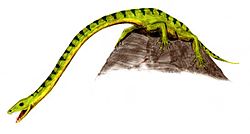User:John Troodon/sandbox/Peculiar Triassic Reptiles
Tanystropheus[edit]
| Tanystropheus Temporal range: Middle Triassic,
| |
|---|---|

| |
| T. longobardicus restoration | |
| Scientific classification | |
| Kingdom: | |
| Phylum: | |
| Class: | |
| Infraclass: | |
| Order: | |
| Family: | |
| Genus: | Tanystropheus Meyer, 1852
|
Tanystropheus is genus of prolacertiformes long - necked archosaur. Its remains were found around Europe, in Switzerland[1], Italy[2], Russia[3][4] etc. Complete skeletons of juvenile individuals are most abundant in the Besano Formation of Italy, dating to 232 million years ago during the middle Triassic period (Ladinian stage)[5].
Paleobiology[edit]
Size[edit]
Tanystropheus was a large animal. It was from 3(10ft) to 6m(20ft). Tanystropheus looked much like a nothosaur, only with smaller head.
Neck[edit]
Tanystropheus is characterized by extremely long neck[6]. Earlier it was thought that tanystropheus held his neck above water and watched down. When it saw fish it poored his neck with the head into the water and caught fish. However this was impossible, because a) itsneck was very delicate;b)It couldn't held its neck above the ground, it was too long;c)It had poor sense of vision[2].
But further studies by D.Dixon[7] showed that Tanystropheus' neck was strengthened by long ribs, which overlapped one another. This adaptation may have helped him to hold its neck straight while swimming.
Paleoecology[edit]
Tanystropheus was not the only the only prolacertiform in Triassic seas. In China[8] his fossils were found among those ofof Dinocephalosaurus, a protorosaur practically similar to Tanystropheus, only slightly smaller. Cosesaurus[9] had shorter neck than Tanystropheus's but still was an effective predator.
Most of prolaceriformes were relatively similar to each other by having a long neck, small head and shortened tail. Some paleontologists even suggested that when the tail of tanystropheus was bitten off it could regrove it, like a lizard. But even with all of these biological innovations, prolacertiformes did not last long - towards Middle Triassic they vanished[10].
The real mystery of protorosaurs and tanystropheids is how they co-existed with each other. It seems that they occupied similar ecological nieche, but perhaps protorosaurs could do something, tanystropheids couldn't - raise their necks. Caudal vertebrae of animals, like Protorosaurus were short and robust, meaning that they were also very powerful.
Discoveries[edit]

Tanystropheus remains were first found by Francisko Bassani. He names the creature "Tribeselodon". His reconstruction shows it as a flying animal. But 30 years before[7], from Germany Hermann von Meyer describes a marine creature he calls -"Tanystropheus"[11]. However, by next 100 years, "Tribeselodon" was thought to be its own species. Even famous Franz Nopzca made his reconstruction. Only in 1968 E.Kui-Schneider puts "Tribeselodon" to "Tanystropheus".

In 2007, in China was found a skeleton of a juvenile Tanystropheus[12][13].
In popular culture[edit]
Because of its bizarre anatomy, Tanystropheus is often featured in films, books etc. In Sea Rex 3D it was featured hunting fish from the shore. However, as I said earlier, it was nearly impossible for a creature with such a long neck to held it higher than its shoulders. In BBC's Sea Monsters is a more accurate reconstruction, where it was fishing underwater.
References[edit]
- ^ A new specimen of Tanystropheus (Reptilia Protorosauria) from the Middle Triassic of Switzerland and the ecology of the genus, S. Renesto
- ^ a b Tanystropheus (Archosauromorpha, Prolacertiformes) remains from the Triassic of the Northern Friuli (NE Italy),F.M. DALLA VECCHIA
- ^ A New Specialized Prolacertilian (Reptilia: Archosauromorpha) from the Lower Triassic of the Orenburg Region, A.G. Sennikov
- ^ NOVYE TANISTROFEIDY (REPTILIA: ARCHOSAUROMORPHA) IZ TRIASA EVROPYA, G. Sennikov
- ^ Dal Sasso, C. and Brillante, G. (2005). Dinosaurs of Italy. Indiana University Press.
- ^ A Triassic aquatic protorosaur with an extremely long neck;C. Li, O. Rieppel
- ^ a b "Dinosaurs"
- ^ A new species of Macrocnemus (Reptilia: Protorosauria) from the Middle Triassic of southwestern China and its palaeogeographical implication, C Li, LJ Zhao
- ^ The prolacertid LepidosaurianCosesaurus aviceps Ellenberger & Villalta, a claimed ĞProtoavian from the Middle Triassic of Spain, J.L. Sanz
- ^ Biochronology of Triassic marine reptiles, S.G.Lucas
- ^ A new protorosaur (Diapsida) from the Upper Buntsandstein of the Black Forest, Germany, N.C. Fraser
- ^ A juvenile Tanystropheus sp.(Protoro sauria: Tanystropheidae) from the Middle Triassic of Guizhou, China; L. Chun
- ^ First record of protorosaurid reptile (Order Protorosauria) from the Middle Triassic of China, L.I. Chun
